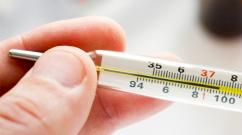Physical properties of air: density, viscosity, specific heat. Density and specific volume of humid air Determination of the weight of air under specified conditions
The main physical properties of air are considered: air density, its dynamic and kinematic viscosity, specific heat, thermal conductivity, thermal diffusivity, Prandtl number and entropy. Air properties are given in tables depending on temperature at normal atmospheric pressure.
Air density versus temperature
A detailed table of the values of the density of air in a dry state at various temperatures and normal atmospheric pressure is presented. What is the density of air? The density of air can be analytically determined by dividing its mass by the volume it occupies under specified conditions (pressure, temperature and humidity). You can also calculate its density using the formula for the ideal gas equation of state. To do this, it is necessary to know the absolute pressure and temperature of the air, as well as its gas constant and molar volume. This equation calculates the dry density of air.
On practice, to find out what is the density of air at different temperatures, it is convenient to use ready-made tables. For example, the given table of values of atmospheric air density depending on its temperature. Air density in the table is expressed in kilograms per cubic meter and is given in the temperature range from minus 50 to 1200 degrees Celsius at normal atmospheric pressure (101325 Pa).
| t, ° С | ρ, kg / m 3 | t, ° С | ρ, kg / m 3 | t, ° С | ρ, kg / m 3 | t, ° С | ρ, kg / m 3 |
|---|---|---|---|---|---|---|---|
| -50 | 1,584 | 20 | 1,205 | 150 | 0,835 | 600 | 0,404 |
| -45 | 1,549 | 30 | 1,165 | 160 | 0,815 | 650 | 0,383 |
| -40 | 1,515 | 40 | 1,128 | 170 | 0,797 | 700 | 0,362 |
| -35 | 1,484 | 50 | 1,093 | 180 | 0,779 | 750 | 0,346 |
| -30 | 1,453 | 60 | 1,06 | 190 | 0,763 | 800 | 0,329 |
| -25 | 1,424 | 70 | 1,029 | 200 | 0,746 | 850 | 0,315 |
| -20 | 1,395 | 80 | 1 | 250 | 0,674 | 900 | 0,301 |
| -15 | 1,369 | 90 | 0,972 | 300 | 0,615 | 950 | 0,289 |
| -10 | 1,342 | 100 | 0,946 | 350 | 0,566 | 1000 | 0,277 |
| -5 | 1,318 | 110 | 0,922 | 400 | 0,524 | 1050 | 0,267 |
| 0 | 1,293 | 120 | 0,898 | 450 | 0,49 | 1100 | 0,257 |
| 10 | 1,247 | 130 | 0,876 | 500 | 0,456 | 1150 | 0,248 |
| 15 | 1,226 | 140 | 0,854 | 550 | 0,43 | 1200 | 0,239 |
At 25 ° C, the air has a density of 1.185 kg / m 3. When heated, the air density decreases - the air expands (its specific volume increases). With an increase in temperature, for example, up to 1200 ° C, a very low air density is achieved, equal to 0.239 kg / m 3, which is 5 times less than its value at room temperature. In general, heat reduction allows a process such as natural convection to take place and is used, for example, in aeronautics.
If we compare the density of air relatively, then air is three orders of magnitude lighter - at a temperature of 4 ° C, the density of water is 1000 kg / m 3, and the density of air is 1.27 kg / m 3. It is also necessary to note the value of the air density under normal conditions. Normal conditions for gases are those at which their temperature is 0 ° C, and the pressure is equal to normal atmospheric. Thus, according to the table, air density under normal conditions (at NU) is equal to 1.293 kg / m 3.
Dynamic and kinematic viscosity of air at different temperatures
When performing thermal calculations, it is necessary to know the value of air viscosity (viscosity coefficient) at different temperatures. This value is required to calculate the Reynolds, Grashof, Rayleigh numbers, the values of which determine the flow regime of this gas. The table shows the values of the coefficients of the dynamic μ and kinematic ν air viscosity in the temperature range from -50 to 1200 ° C at atmospheric pressure.
The viscosity coefficient of air increases significantly with an increase in its temperature. For example, the kinematic viscosity of air is 15.06 · 10 -6 m 2 / s at a temperature of 20 ° C, and with an increase in temperature to 1200 ° C, the viscosity of air becomes equal to 233.7 · 10 -6 m 2 / s, that is, it increases 15.5 times! The dynamic viscosity of air at a temperature of 20 ° C is equal to 18.1 · 10 -6 Pa · s.
When the air is heated, the values of both kinematic and dynamic viscosity increase. These two quantities are interconnected through the value of the air density, the value of which decreases when this gas is heated. An increase in the kinematic and dynamic viscosity of air (as well as other gases) during heating is associated with a more intense vibration of air molecules around their equilibrium state (according to the MKT).
| t, ° С | μ · 10 6, Pa · s | ν · 10 6, m 2 / s | t, ° С | μ · 10 6, Pa · s | ν · 10 6, m 2 / s | t, ° С | μ · 10 6, Pa · s | ν · 10 6, m 2 / s |
|---|---|---|---|---|---|---|---|---|
| -50 | 14,6 | 9,23 | 70 | 20,6 | 20,02 | 350 | 31,4 | 55,46 |
| -45 | 14,9 | 9,64 | 80 | 21,1 | 21,09 | 400 | 33 | 63,09 |
| -40 | 15,2 | 10,04 | 90 | 21,5 | 22,1 | 450 | 34,6 | 69,28 |
| -35 | 15,5 | 10,42 | 100 | 21,9 | 23,13 | 500 | 36,2 | 79,38 |
| -30 | 15,7 | 10,8 | 110 | 22,4 | 24,3 | 550 | 37,7 | 88,14 |
| -25 | 16 | 11,21 | 120 | 22,8 | 25,45 | 600 | 39,1 | 96,89 |
| -20 | 16,2 | 11,61 | 130 | 23,3 | 26,63 | 650 | 40,5 | 106,15 |
| -15 | 16,5 | 12,02 | 140 | 23,7 | 27,8 | 700 | 41,8 | 115,4 |
| -10 | 16,7 | 12,43 | 150 | 24,1 | 28,95 | 750 | 43,1 | 125,1 |
| -5 | 17 | 12,86 | 160 | 24,5 | 30,09 | 800 | 44,3 | 134,8 |
| 0 | 17,2 | 13,28 | 170 | 24,9 | 31,29 | 850 | 45,5 | 145 |
| 10 | 17,6 | 14,16 | 180 | 25,3 | 32,49 | 900 | 46,7 | 155,1 |
| 15 | 17,9 | 14,61 | 190 | 25,7 | 33,67 | 950 | 47,9 | 166,1 |
| 20 | 18,1 | 15,06 | 200 | 26 | 34,85 | 1000 | 49 | 177,1 |
| 30 | 18,6 | 16 | 225 | 26,7 | 37,73 | 1050 | 50,1 | 188,2 |
| 40 | 19,1 | 16,96 | 250 | 27,4 | 40,61 | 1100 | 51,2 | 199,3 |
| 50 | 19,6 | 17,95 | 300 | 29,7 | 48,33 | 1150 | 52,4 | 216,5 |
| 60 | 20,1 | 18,97 | 325 | 30,6 | 51,9 | 1200 | 53,5 | 233,7 |
Note: Be careful! Air viscosity is given in the power of 10 6.
Specific heat capacity of air at temperatures from -50 to 1200 ° С
A table of specific heat capacity of air at different temperatures is presented. Heat capacity in the table is given at constant pressure (isobaric heat capacity of air) in the temperature range from minus 50 to 1200 ° C for dry air. What is the specific heat of air? The specific heat value determines the amount of heat that must be supplied to one kilogram of air at constant pressure to increase its temperature by 1 degree. For example, at 20 ° C, to heat 1 kg of this gas by 1 ° C in an isobaric process, 1005 J of heat is required.
The specific heat capacity of air increases with an increase in its temperature. However, the dependence of the mass heat capacity of air on temperature is not linear. In the range from -50 to 120 ° C, its value practically does not change - under these conditions, the average heat capacity of air is 1010 J / (kg · deg). According to the table, it can be seen that temperature begins to have a significant effect from 130 ° C. However, air temperature affects its specific heat much weaker than viscosity. So, when heated from 0 to 1200 ° C, the heat capacity of air increases only 1.2 times - from 1005 to 1210 J / (kg · deg).
It should be noted that the heat capacity of humid air is higher than that of dry air. If we also compare air, then it is obvious that water has a higher value and the water content in the air leads to an increase in the specific heat capacity.
| t, ° С | C p, J / (kg deg) | t, ° С | C p, J / (kg deg) | t, ° С | C p, J / (kg deg) | t, ° С | C p, J / (kg deg) |
|---|---|---|---|---|---|---|---|
| -50 | 1013 | 20 | 1005 | 150 | 1015 | 600 | 1114 |
| -45 | 1013 | 30 | 1005 | 160 | 1017 | 650 | 1125 |
| -40 | 1013 | 40 | 1005 | 170 | 1020 | 700 | 1135 |
| -35 | 1013 | 50 | 1005 | 180 | 1022 | 750 | 1146 |
| -30 | 1013 | 60 | 1005 | 190 | 1024 | 800 | 1156 |
| -25 | 1011 | 70 | 1009 | 200 | 1026 | 850 | 1164 |
| -20 | 1009 | 80 | 1009 | 250 | 1037 | 900 | 1172 |
| -15 | 1009 | 90 | 1009 | 300 | 1047 | 950 | 1179 |
| -10 | 1009 | 100 | 1009 | 350 | 1058 | 1000 | 1185 |
| -5 | 1007 | 110 | 1009 | 400 | 1068 | 1050 | 1191 |
| 0 | 1005 | 120 | 1009 | 450 | 1081 | 1100 | 1197 |
| 10 | 1005 | 130 | 1011 | 500 | 1093 | 1150 | 1204 |
| 15 | 1005 | 140 | 1013 | 550 | 1104 | 1200 | 1210 |
Thermal conductivity, thermal diffusivity, Prandtl number of air
The table shows such physical properties of atmospheric air as thermal conductivity, thermal diffusivity and its Prandtl number depending on temperature. Thermophysical properties of air are given in the range from -50 to 1200 ° C for dry air. According to the data in the table, it can be seen that the indicated properties of air significantly depend on temperature and the temperature dependence of the considered properties of this gas is different.
Physics at every turn Perelman Yakov Isidorovich
How much does the air in the room weigh?
Can you roughly tell what kind of weight the air is holding in your room? Several grams or several kilograms? Are you able to lift such a load with one finger, or would you barely keep it on your shoulders?
Now, perhaps, there are no longer people who think, as the ancients believed, that air weighs nothing at all. But to say how much a certain volume of air weighs, many will not be able to now.
Remember that a liter mug of air of the same density as it has near the earth's surface at normal room temperature weighs about 1.2 g. Since a cubic meter contains 1 thousand liters, a cubic meter of air weighs a thousand times more than 1.2 g, namely 1.2 kg. Now it is not difficult to answer the question posed earlier. To do this, you just need to find out how many cubic meters there are in your room, and then the weight of the air contained in it will be determined.
Let the room have an area of 10 m 2 and a height of 4 m. In such a room there are 40 cubic meters of air, which therefore weighs forty times 1.2 kg. This will amount to 48 kg.
So, even in such a small room, the air weighs a little less than you yourself. Carrying such a load on your shoulders would not be easy for you. And the air of a twice as spacious room, loaded on your back, could crush you.
This text is an introductory fragment. From the book The newest book of facts. Volume 3 [Physics, chemistry and technology. History and archeology. Miscellaneous] the author Kondrashov Anatoly Pavlovich From the book History of the Candle author Faraday Michael From the book Five Unsolved Problems of Science author Wiggins Arthur From the book Physics at every turn the author Perelman Yakov Isidorovich From the book Movement. Heat the author Kitaygorodsky Alexander Isaakovich From the book NIKOLA TESLA. LECTURES. ARTICLES. author Tesla Nikola From the book How to understand the complex laws of physics. 100 simple and fun experiences for kids and their parents the author Dmitriev Alexander Stanislavovich From the book by Marie Curie. Radioactivity and Elements [The Most Intimate Secret of Matter] the author Paez Adela Muñoz From the author's bookLECTURE II CANDLE. BRIGHTNESS OF THE FLAME. COMBUSTION NEEDS AIR. FORMATION OF WATER In the last lecture, we looked at the general properties and location of the liquid part of a candle, as well as how this liquid gets to where combustion occurs. You made sure that when the candle
From the author's bookLocally Produced Air Since the inner planets - Mercury, Venus, Earth, and Mars - are close to the Sun (Figure 5.2), it is reasonable to assume that they consist of the same raw material. This is true. Rice. 5.2. Orbits of the planets of the solar system
From the author's bookHow much air are you breathing in? It is also interesting to calculate how much the air that we inhale and exhale during one day weighs. With each breath, a person injects about half a liter of air into their lungs. We do, on the average, 18 breaths per minute. Hence, for one
From the author's bookHow much does all the air on Earth weigh? The experiments now described show that a column of water 10 meters high weighs the same as a column of air from the Earth to the upper boundary of the atmosphere, and therefore they balance each other. Therefore, it is not difficult to calculate how much
From the author's bookIron vapor and solid air Isn't that a strange combination of words? However, this is not at all nonsense: both iron vapor and solid air exist in nature, but not under ordinary conditions. What kind of conditions are we talking about? The state of matter is determined by two
From the author's bookFIRST ATTEMPTS TO GET A SELF-OPERATING MOTOR - MECHANICAL OSCILLATOR - DUAR'S WORK AND LINDE - LIQUID AIR Realizing this truth, I began to look for ways to fulfill my idea, and after long reflections, I finally came up with an apparatus that could receive
From the author's book51 Lightning tamed right in the room - and safe! For experience we need: two balloons. Everyone has seen the lightning. A terrible electrical discharge strikes directly from the cloud, burning everything that it hits. This spectacle is both scary and attractive. Lightning is dangerous, it kills all living things.
From the author's bookHOW? Even before she began studying uranium rays, Maria had already decided that prints on photographic films were an imprecise method of analysis, and she wanted to measure the intensity of the rays and compare the amount of radiation emitted by various substances. She knew Becquerel
Compressed air- This is air under pressure exceeding atmospheric pressure.
Compressed air is a unique energy carrier along with electricity, natural gas and water. In industrial conditions, compressed air is mainly used to drive pneumatically driven devices and mechanisms (pneumatic drive).
In everyday, everyday life, we practically do not notice the Air around us. However, throughout the history of mankind, people have used the unique properties of air. The invention of the sail and the forge, the windmill and the hot air balloon were the first steps in the use of air as an energy carrier.
With the invention of the compressor, the era of the industrial use of compressed air came. And the question: "
what is Air, and what properties does it possess? " - has become far from idle.When starting to design a new pneumatic system or modernizing an existing one, it will be useful to remember and
about some properties of air, terms and units of measurement.Air is a mixture of gases, mainly nitrogen and oxygen.
|
Air composition |
|||
|
Element* |
Designation |
By volume,% |
By mass, % |
|
Oxygen |
|||
|
Carbon dioxide |
CO 2 |
||
|
CH 4 |
|||
|
H 2 O |
|||
The average relative molar mass is -28.98. 10 -3 kg / mol
* Air composition may vary. Typically, in industrial areas, air contains
Density and specific volume of humid air are variables that depend on temperature and air. These values need to be known when selecting fans for, when solving problems related to the movement of a drying agent through air ducts, when determining the power of fan motors.This is the mass (weight) of 1 cubic meter of a mixture of air and water vapor at a certain temperature and relative humidity. Specific volume is the volume of air and water vapor per kg of dry air.
Moisture and heat content
The mass in grams per unit mass (1 kg) of dry air, in their total volume is called moisture content of air... It is obtained by dividing the density of water vapor in the air, expressed in grams, by the density of dry air in kilograms.To determine the heat consumption for moisture, you need to know the value heat content of humid air... This value is understood as the air and water vapor contained in the mixture. It is numerically equal to the sum:
Air density is a physical quantity that characterizes the specific gravity of air under natural conditions or the mass of gas in the Earth's atmosphere per unit volume. The value of air density is a function of the height of the measurements being made, of its humidity and temperature.
The air density standard is a value equal to 1.29 kg / m3, which is calculated as the ratio of its molar mass (29 g / mol) to the molar volume, the same for all gases (22.413996 dm3), corresponding to the density of dry air at 0 ° C (273.15 ° K) and a pressure of 760 mm Hg (101325 Pa) at sea level (that is, under normal conditions).
Not so long ago, information about the density of air was obtained indirectly through observations of auroras, the propagation of radio waves, and meteors. Since the advent of artificial satellites of the Earth, the air density began to be calculated thanks to the data obtained from their deceleration.
Another method is to observe the spreading of artificial clouds of sodium vapor generated by meteorological rockets. In Europe, the air density at the Earth's surface is 1.258 kg / m3, at an altitude of five km - 0.735, at an altitude of twenty km - 0.087, at an altitude of forty km - 0.004 kg / m3.
There are two types of air density: mass and weight (specific gravity).
The weight density determines the weight of 1 m3 of air and is calculated by the formula γ = G / V, where γ is the weight density, kgf / m3; G is the weight of air, measured in kgf; V is the volume of air, measured in m3. Determined that 1 m3 of air at standard conditions(barometric pressure 760 mm Hg, t = 15 ° С) weighs 1,225 kgf based on this, the weight density (specific gravity) of 1 m3 of air is γ = 1.225 kgf / m3.
It should be taken into account that air weight is a variable quantity and varies depending on various conditions, such as latitude and the force of inertia that occurs when the Earth rotates around its axis. At the poles, the weight of air is 5% more than in the equator zone.
The mass density of air is the mass of 1 m3 of air, denoted by the Greek letter ρ. As you know, body weight is a constant value. The unit of mass is considered to be the mass of weights made of iridist platinum, which is kept in the International Chamber of Weights and Measures in Paris.
The mass density of air ρ is calculated using the following formula: ρ = m / v. Here m is the mass of air, measured in kg × s2 / m; ρ is its mass density, measured in kgf × s2 / m4.
Mass and weight density of air are dependent on: ρ = γ / g, where g is the coefficient of acceleration of gravity, equal to 9.8 m / s². Whence it follows that the mass density of air under standard conditions is 0.1250 kg × s2 / m4.
As barometric pressure and temperature change, air density changes. Based on the Boyle-Mariotte law, the higher the pressure, the greater the density of the air. However, with a decrease in pressure with height, the density of air also decreases, which introduces its own corrections, as a result of which the law of pressure change along the vertical becomes more complicated.
The equation that expresses this law of pressure change with height in the atmosphere at rest is called the basic equation of statics.
It says that with an increase in altitude, the pressure changes downward and when rising to the same height, the decrease in pressure is the greater, the greater the force of gravity and the density of the air.
Air density changes play an important role in this equation. As a result, we can say that the higher you go, the less pressure will drop when you rise to the same height. The density of air depends on temperature as follows: in warm air, the pressure decreases less intensely than in cold air, therefore, at the same height in warm air mass, the pressure is higher than in cold air.
With changing values of temperature and pressure, the mass density of air is calculated by the formula: ρ = 0.0473xV / T. Here B is the barometric pressure, measured in mm Hg, T is the air temperature, measured in Kelvin.
How do you choose, according to what characteristics, parameters?
What is an industrial compressed air dryer? Read about it, the most interesting and relevant information.
What are the prices for ozone therapy now? You will learn about this in this article:
... Reviews, indications and contraindications for ozone therapy.

Also, the density is determined by the humidity of the air. The presence of water pores leads to a decrease in air density, which is explained by the low molar mass of water (18 g / mol) against the background of the molar mass of dry air (29 g / mol). Moist air can be considered as a mixture of ideal gases, in each of which the combination of densities allows you to obtain the required density value for their mixture.
This kind of interpretation allows the determination of density values with an error level of less than 0.2% in the temperature range from -10 ° C to 50 ° C. The density of air allows you to get the value of its moisture content, which is calculated by dividing the density of water vapor (in grams), which is contained in the air, by the density of dry air in kilograms.
The basic equation of statics does not allow solving constantly arising practical problems in the real conditions of a changing atmosphere. Therefore, it is solved under various simplified assumptions that correspond to actual real conditions, due to the advancement of a number of particular assumptions.
The basic equation of statics makes it possible to obtain the value of the vertical pressure gradient, which expresses the change in pressure during ascent or descent per unit of height, i.e., the change in pressure per unit of vertical distance.
Instead of a vertical gradient, the opposite value is often used - a baric step in meters per millibar (sometimes an outdated version of the term "pressure gradient" is still found - a barometric gradient).
Low air density results in little movement resistance. Many terrestrial animals, in the course of evolution, used the ecological benefits of this property of the air environment, due to which they acquired the ability to fly. 75% of all species of land animals are capable of active flight. For the most part these are insects and birds, but there are mammals and reptiles.
Air Density Determination Video













